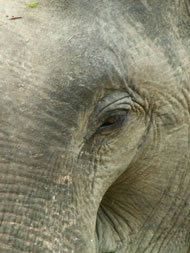THE LARGEST REMAINING population of wild Asian elephants inhabit the Nilgiris biosphere reserve in India, where more than 1000 elephants survive in a near contiguous habitat. There are more elephants in the Nilgiris reserve than in any other country in Asia.
They range through the three south Indian states of Tamil Nadu, Kerala and Karnataka following a seasonal food supply along paths they have travelled since time immemorial. However, some of these corridors are being disrupted, threatening the elephants’ very survival.
There are two main threats: elephants moving from Karnataka to Kerala have to pass through a ‘corridor’ which is only about 2.5 km wide. An inter-state highway passes through this corridor and is used by hundreds of vehicles daily. In addition, there are four government check-posts located on the Kerala side which are to be relocated to the centre of this corridor, further disrupting the elephants’ migratory route. With the likelihood of hundreds of lorries parked along the road effectively cutting-off this vital lifeline and the encroachment of the check-posts – which could be located outside the corridor where suitable land is available – the elephants’ wellbeing will be undermined.
The second threat to these same elephants lies in Tamil Nadu, where the best wet-season forage is found. Here a vast physics experiment is planned: the US $167 million India-based Neutrino Observatory (INO). During the summer, as food and water becomes scarce, elephants need to migrate from Tamil Nadu to Kerala. To do so they must pass through a corridor at Singara, right where the INO is to be located. The proposal would tunnel more than two kilometers and build a 100,000 ton neutrino-detector underground. This will require over 150,000 truckloads of material to pass through thirty-five kilometers of elephant habitat - and two tiger reserves.
There has been no systematic attempt to determine the best site for this project which is not actually site-specific and could be built elsewhere. Indeed, they could hardly have picked a site in India more likely to damage wildlife. As well as being home to the largest single population of Asian elephants in the world the Nilgiris is also one of the most important tiger habitats in the country. 676 species of plants, 173 species of vertebrates, 12 species of amphibians, 38 species of fish, 46 species of reptile, 87 species of birds and 28 species of mammals (including tiger, leopard, gaur, wild dog, bear, deer and elephant) live around the proposed site for these projects.
The conservation of this critical elephant habitat would not only serve to protect the largest Asian elephant population in the world, but would also benefit the entire ecosystem, including all the other rare species. Which is why the Nilgiris was declared as a UNESCO Bio-sphere reserve in the first place.
Please go to bit.ly/india_elephants where in less than a minute you can send emails to over twenty officials in the two states who could, if they wished, protect these elephants. For more information, photos, artwork and poetry, go to www.rainforestinfo.org.au/e/appeal.htm
John Seed is s an Australian environmentalist and director of the Rainforest Information Centre.








